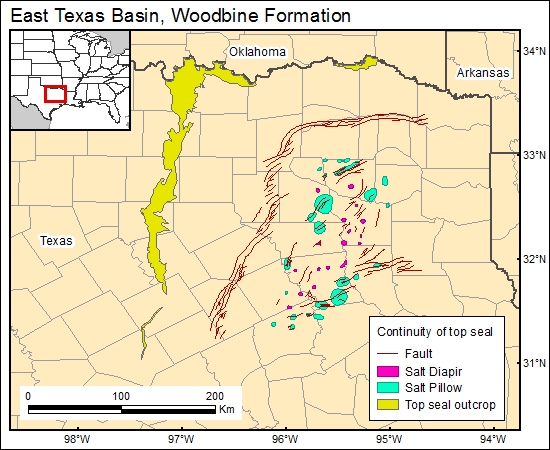Woodbine Formation, East Texas Basin (08)
Comments on Geologic Parameters
08 Continuity of Top Seal:
The Eagle Ford has been eroded over the Sabine Uplift in the eastern part of the study area (see 7woodbine); however, the low-transmissivity Austin Chalk extends over this area. Faults of the Mexia-Talco and Elkhart-Mt. Enterprise fault zones cut the seals. These faults create traps for oil fields, the extent to which they may locally leak unknown. Fault zones have isolated Woodbine sandstones within the basin from recharge zones in Woodbine outcrops on the east and north basin edges (Kreitler and others, 1984). If these faults can be shown to be tight to CO2, this geometry may create a desirably large but hydrologically isolated brine volume. Salt diapers penetrate the Cretaceous section, and there is some evidence of at least geologic rates of discharge up some dome flanks (Kreitler and others, 1984). In the structurally and stratigraphically complex areas around salt diapers, site-specific data on the potential for leakage are needed. Nonpenetrative salt pillows may also impact flow at depth.
08 Map:

08 Reference:
Kreitler, C. W., Collins. E. W., Fogg, G. E., Jackson, M. P. A., and Seni, S. J., 1984, Hydrogeological characterization of the saline aquifers, East Texas Basin—implications to nuclear waste storage in East Texas salt domes: The University of Texas at Austin, Bureau of Economic Geology, contract report prepared for U.S. Department of Energy, under contract no. DE-AC97-80ET46617, 156 p.
Seni, S. J., and Jackson, M. P. A., 1984, Sedimentary records of Cretaceous and Tertiary salt movement, East Texas Basin: times, rates, and volumes of flow, implications to nuclear waste isolation and petroleum exploration: The University of Texas at Austin, Bureau of Economic Geology Report of Investigations No. 139, 89 p.



